As we left Ecuador behind and entered Peru, the landscape began to change dramatically. The green, mountainous terrain fell away and we descended into a dry and sandy desert. Our first impressions of Peru were not overly positive; it seemed grey, barren and covered with rubbish. We drove along the coast, and eventually stopped at a beach near Punta Sal, a fairly isolated and chilled out spot where we put up our tents and watched the sunset.
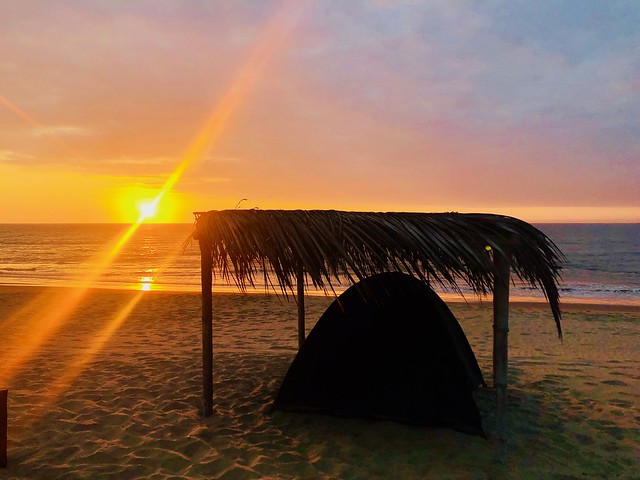
Camping on the beach near Punta Sal

Recreating the ‘Simba Circle of Life’ moment from the Lion King
Our next stop in Peru was the town of Mancora, which was also by the beach but much less chilled out. We stayed at ‘party’ hostel Loki del Mar, where every other hour was happy hour and two super-strength cocktails cost 10 soles (about £2.30). With little to see and do around the town, a few of the girls decided to take part in the daily volleyball competition, and were rewarded for their efforts with copious amounts of alcohol.

Marisa, Jess, Andrea and Holly drinking between rounds of volleyball
Over the years I have had many terrible alcohol related experiences (and some really terrible hangovers), and as a result I don’t drink particularly often these days, but with very little else going on and very cheap drinks available, it seemed as though the best course of action was to embrace the party atmosphere and have a couple of cocktails. Giant games of jenga and a UV party inevitably followed, and at one point I found myself dancing with the local drug dealer. Thanks to Shane I made a quick escape, but there was still plenty of drama that night as certain members of our Oasis group took advantage of their single status (and took advantage of the availability of certain substances, thanks to said drug dealer) and mingled with the other hostel guests. I think it’s fair to say that no one got too much sleep that night.
The next day we had to get up early for a long drive day to the town of Huanchaco. According to google maps, the drive was about 600 kilometres, and should have taken about nine hours, but we were travelling in a 17-tonne truck and averaged about 50 kilometres an hour on a good day. The chaos of the night before meant we inevitably set off late, and then around half an hour into our drive, Holly discovered she had left her camera behind at the hostel in Mancora. We turned around, retrieved the camera, and started our very long drive all over again. It was a very long day with a lot of very hungover passengers.
We took advantage of a free day in Huanchaco to explore the Chan Chan ruins. With an area of 20 square kilometres, Chan Chan is the largest mud brick city in the world. We took a guided tour of the site and enjoyed looking at the carvings in the mud bricks, which resembled pelicans, fish and various other animals, and learning about what life would have been like 700 years ago in Chan Chan.
In the afternoon, we visited a local shopping centre to stock up on supplies, and managed to stumble across a large group of people watching Peru play Denmark in the World Cup on a big screen. Unfortunately Peru didn’t win, but that didn’t seem to dent the excitement of those watching, who erupted in huge cheers every time Peru took possession of the ball. Back at base, some members of our group made the most of Huanchaco’s reputation as ‘surfer’s paradise’ by renting a couple of boards, and Hattie discovered a new talent for surfing.

Fish patterns at the Chan Chan ruins
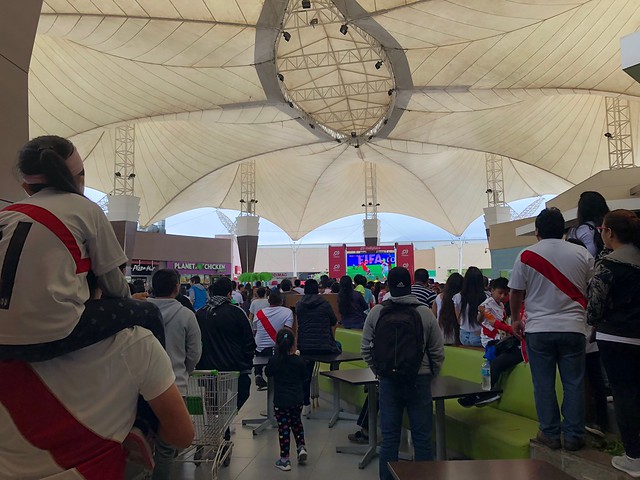
Watching Peru not win the World Cup
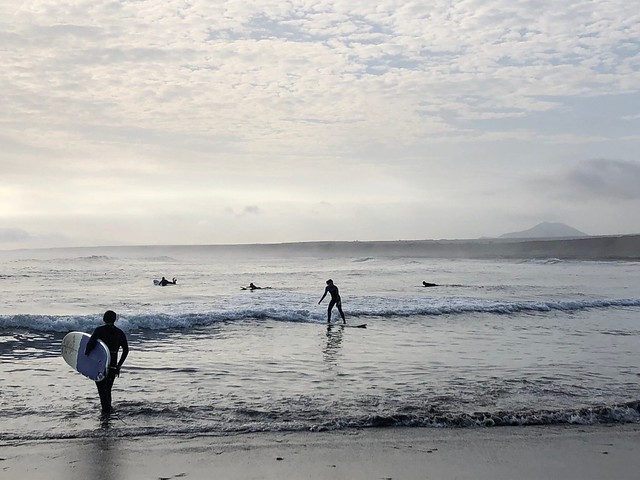
Hattie making it look easy
From Huanchaco we had two days of driving to Lima, the capital city of Peru. We broke the drive with a bush camp by the beach, where we had a BBQ, watched the sunset and toasted marshmallows by the fire. Shane and I also climbed a nearby hill to check out the view, which started off well but resulted in me breaking my one and only pair of flip flops, meaning I am now down to one pair of shoes for the rest of the trip.
Lima itself did not help to improve my overall impression of Peru. With a reputation for being dangerous, boring and ugly, my expectations weren’t high. As we drove through the dirty and dusty streets, Lima didn’t seem particularly inspiring. We took a free walking tour of the city with the cute but perhaps not particularly knowledgeable Franco, where we learnt interesting facts about Lima, such as “people like to dance”, and “you can get the train from here to Cuzco”. We saw various sights on our tour including the Palace of Pizarro and the train station, where were reminded once again that we could take the train out of Lima if we wanted to.
In the evening we met two new members of our group; 19 year old Will from Wiltshire and 21 year old Ryan from Northern Ireland. To welcome them to the group we decided to switch our names around (I introduced myself as “Holly”, while Shane became “James”), and invented some fictional background stories. I upped my age a bit, while Hattie (from now on known as “Mary”) pretended to be younger, and Shane and I introduced ourselves as her parents. Ryan didn’t buy this for one moment, and still thought I must be lying when I told him my real age (28).
The name-switch started off well, but quickly began to unravel when we took a taxi to Lima’s ‘Magic Water Show’ and the real Holly left her phone in the taxi. Some frantic whatsapp messages, phone calls and general panic followed, and both Will and Ryan sussed that we weren’t telling the complete truth about our names. Nevertheless, the ‘Magic Water Show’ turned out to be one of the highlights of our time in Lima, with elaborate water features and bright projections. We also had some fun when Ryan decided to lower the tone and climb into one of the fountains, and when we had to fit ten of us (plus the taxi driver) into a seven-seater car on the way home. Once we arrived back at the hotel we had our faith in Lima restored when the taxi driver from earlier in the night came by to return Holly’s phone.

Andrea balancing in front of the water

Ryan giving in to peer pressure
—
We left Lima and drove further into the Peruvian desert. Our next stop was Huacachina, a small oasis surrounded by towering, dramatic sand dunes. Our whole group elected to take part in dune buggying and sandboarding across the dunes, which was far scarier than I anticipated. Our driver raced up and down huge sand dunes as fast as he could, and we screamed as we plunged over the edge. Sandboarding was even more terrifying; it involved lying on a small board and racing head first down some huge, steep sand dunes.
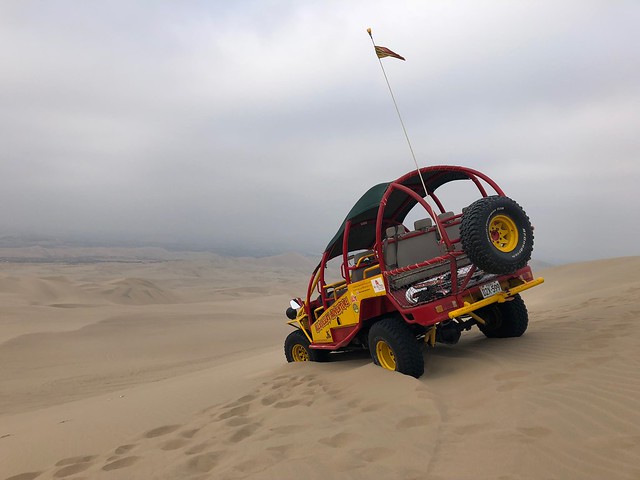
Our dune buggy

Will, Andrea, Hattie, James, me, Shane, Holly, Jess, Ryan and Marisa ready to board
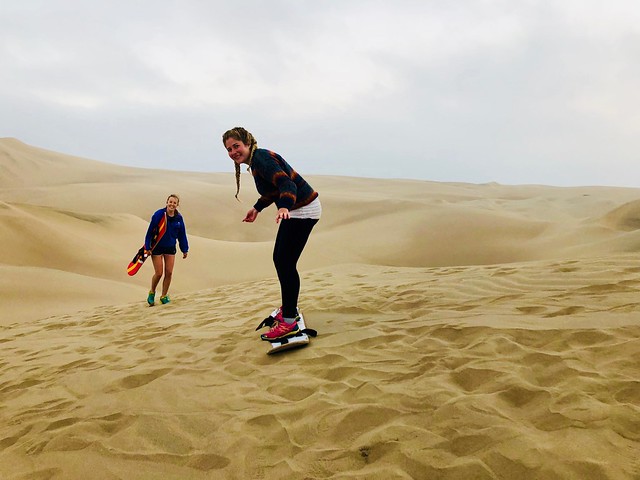
Having a go at standing up
On one occasion I managed to come off the board, and lay in a crumpled heap on the ground. Will and Andrea had to come and pick me up and dust me off as there was sand everywhere, all over everything. Moments later the same thing happened to Hattie, who ended up vomiting sand because she swallowed so much. As the days passed after sandboarding I continued to find sand everywhere – in my ears, in my hair, in my clothes and between my toes.

Hattie eating sand
Once we’d had enough of the sand based adventure sports, we continued on our sandy trip to Nazca, famous for a series of large, ancient geometric figures marked in the sand. The Nazca Lines are made up of over 800 straight lines, 300 geometric figures and 70 animal and plant drawings. They are estimated to have been created between 500 BCE and 500 AD, but at up to 370 metres long, they are best seen from the air.
The Nazca Lines remain one of the world’s great archeological mysteries. No one knows who made them, or how or why they were made. One theory is that the Nazca people knew how to construct hot-air balloons, which allowed them to observe the lines from the air. Another idea isthat the lines formed a giant running track, and one particularly popular theory is that they are evidence of a visit from an alien civilization.
With a hefty price tag, a reputation for inducing motion sickness and a fatal crash occurring almost every year, Shane and I opted not to take a flight over the lines. Instead we climbed up a rickety tower in the middle of the desert to look over the ‘lizard’, the ‘tree’, and the ‘frog’, which cost only 2 soles (40p) when we managed to produce some fake student cards (thank you out of date EHIC). Marisa, Will, James and Ryan took one of the little planes and reported that it was a worthwhile experience.
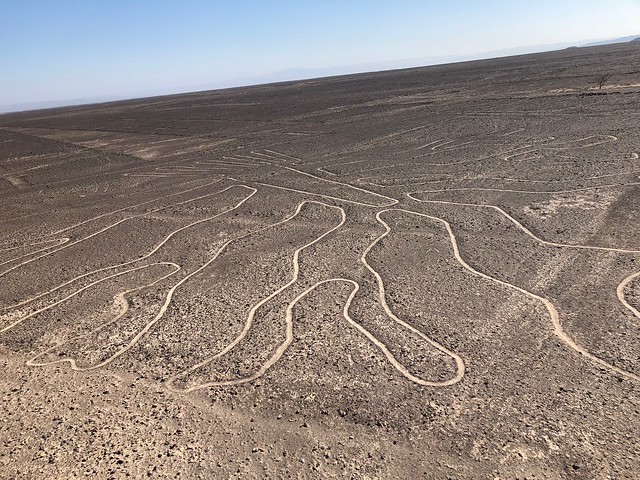
View of the Nazca lines from the small metal tower
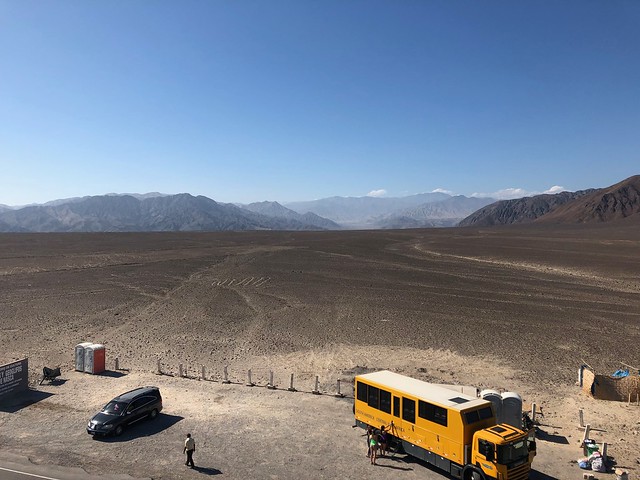
Spongebob (our truck) checking out the Nazca lines
From Nazca we continued our drive through the Peruvian desert, stopping for a guided tour of Chauchilla cemetery where observed various ancient mummies and bones. In the evening we bush camped on the beach, and said a final goodbye to the Pacific Ocean. The next time we see the sea we will be back at the Atlantic.
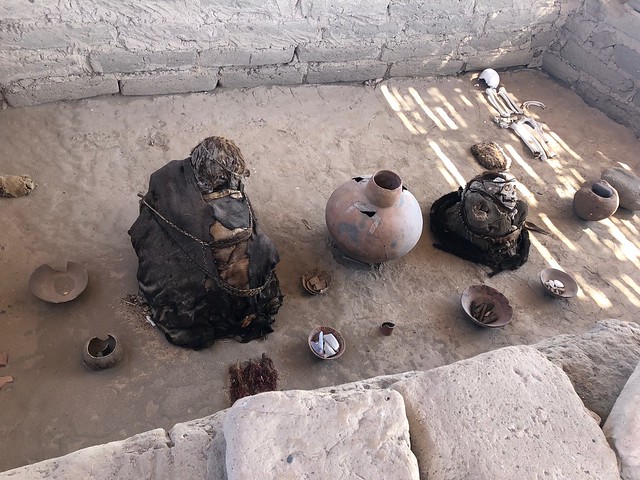
Mummies at Chauchilla cemetry
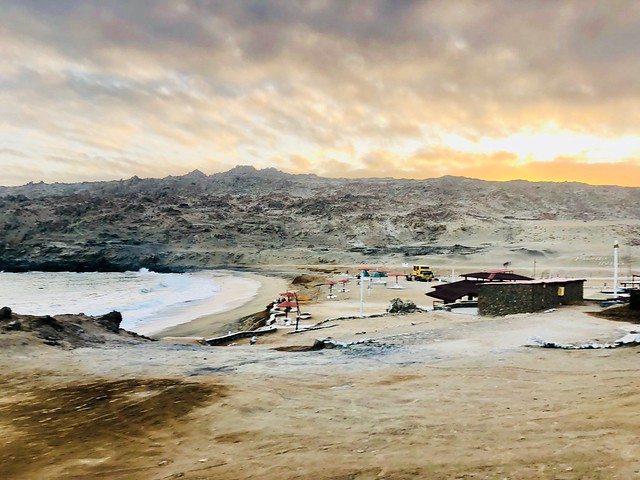
Sunset over our desert / beach bush camp
Eventually it was time to leave the desert (and sea level) behind us. We drove from the coast to Arequipa, Peru’s second most populous city. Set in the mountains at a height of 2,300 metres above sea level, Arequipa was prettier and more relaxed than Lima, and we quickly settled in to exploring the city. We took another free walking tour, visited the well preserved frozen body of an Inca girl who was killed at the top of a mountain as an offering to the Inca gods around 550 years ago (ice maiden Juanita) and enjoyed a delicious meal of alpaca to celebrate Marisa’s birthday.
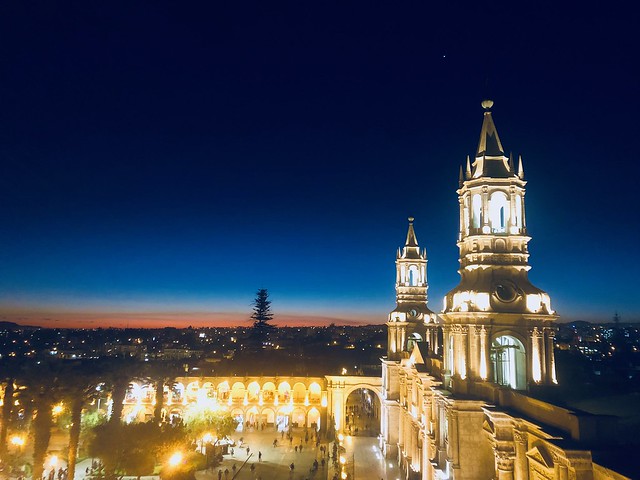
Sunset over Arequipa
On our second day in Arequipa we decided to take a tour to “nearby” Colca Canyon, the second deepest canyon in the world, famed for being home to the Andean condor. As we had to get up at 3am and drive for four hours to get there, it turned out that Colca Canyon is actually not that close to Arequipa, and that a one-day tour from the city is not, in fact, particularly practical or desirable. We drove along some very twisty roads, up to a height of over 4,000 metres, and the result wasn’t pleasant. While the canyon and the condors were suitably spectacular, I got car sick, Jess got car sick, and Hattie got really sick. So sick, in fact, that she had to be taken by ambulance to hospital, where she remained for the next few days.

Watching condors fly over Colca Canyon
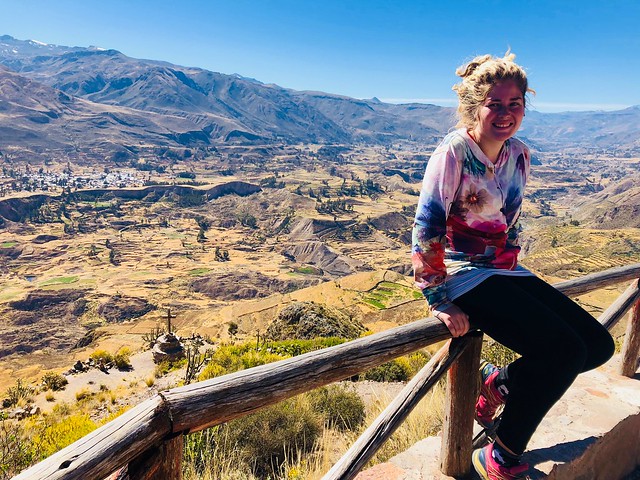
Views of Colca Valley

Spotted an alpaca!

Wearing an alpaca!
Leaving Hattie and our tour leader (Gayle) behind us in Arequipa, we continued our drive through the mountains to Cuzco, where we would start our trek to Machu Picchu. We took turns to sit with our driver (James) in the front of the truck, and bush camped at 4,000 metres in a disused quarry. That night Jess took control of the cooking, making a chilli so spicy that no one could stomach it. On the plus side, it warmed us up ahead of a night so cold that night that we were greeted to a layer of ice on the outside of our tents.
Meeting the locals on our way through

Watching out for llamas with driver James in the front of the truck
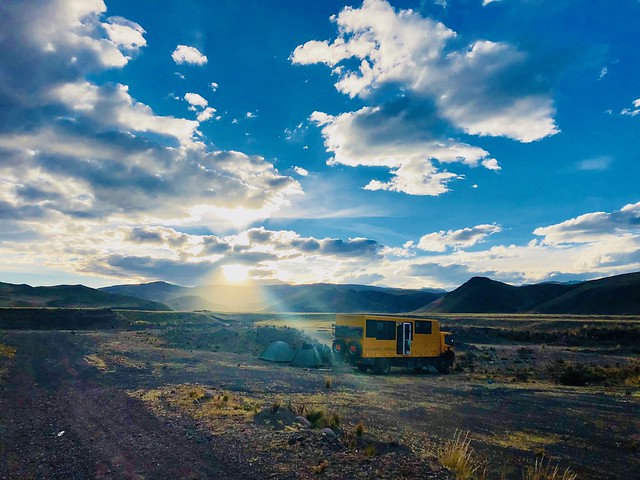
Bush camping in the mountains at 4,000m
After another long and winding drive day, we finally arrived in Cuzco, the historic centre of the Inca Empire, and our gateway to Machu Picchu. The dry, dusty desert was a distant memory and snow capped mountains, beautiful valleys and ancient Inca ruins beckoned as we prepared to start our trek to one of the new seven wonders of the world. While our first impressions of Peru were underwhelming, we were starting to see a different side to the country. Rather than a barren plane of sand, Peru is rich with history, natural wonders, and plenty of llamas.
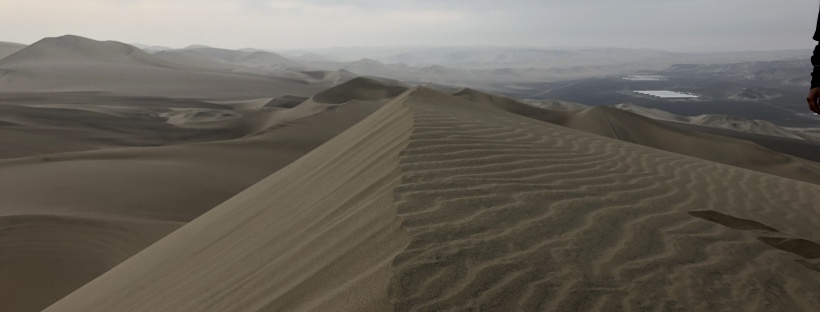
I look forward to your entertaining travelogues.
Glad to see that you don’t indulge in every hair raising adventure.
I wonder if von Daniken was right?
Came across a tip on Facebook – talcum powder helps to get rid of sand ( tho perhaps not from the mouth)
Another wonderful adventure-we totally admire you both. What / how will you ever settle down after all the travels?